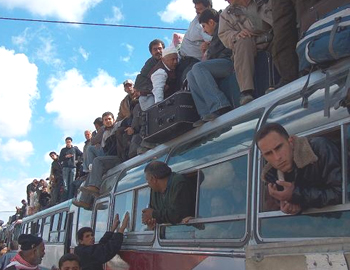Rafah Crossing
http://www.btselem.org/gaza_strip/rafah_crossing
Immediately after Israel occupied the Gaza Strip in 1967, the Israeli army issued an order defining the Strip a closed military area. Until 1991, residents of the Gaza Strip could leave the area freely for Israel and the West Bank under a general permit. After 1991, they were required to obtain a personal exit permit, which entailed many bureaucratic difficulties and vague and arbitrary criteria.
In September 2005, following the withdrawal of Israeli forces from the Gaza Strip, Israel issued an order declaring the end of the military government there. However, Israel continues to control almost all the exit and entry points around the Gaza Strip. The area borders Israel on the north and east, and entry into Israel is possible only at crossings under its control. Access to and from the Gaza Strip by sea, to the west, and by air, is under Israel’s exclusive control.
Rafah Crossing, on the other hand, is located on the border between the Gaza Strip and Egypt. Initially, it was widely assumed that the disengagement had also ended Israel’s control of this crossing, and that free passage would now be possible. It quickly became clear that matters were more complicated.
Following the disengagement, Rafah Crossing was closed for three months. In November 2005, the Crossings Agreement was signed by Israel and the Palestinian Authority. The agreement established that the crossing would be operated by the Palestinian Authority, under monitoring of the European Union and remote monitoring by Israeli security personnel. The agreement enabled Gazans holding Palestinian identity cards to cross. For seven months, the crossing operated in an orderly manner, and some 1,320 persons crossed daily.
On 25 June 2006, following the abduction of the soldier Gilad Shalit, Israel decided to close the crossing. It informed the European monitors that the crossing was closed for security reasons, and ceased to carry out its part of the agreement. Israel allowed the crossing to be opened only in isolated cases, and without giving advance notice. From then until June 2007, the crossing was closed for 265 days.
After Hamas took control of the Gaza Strip in June 2007, Israel announced the freezing of the Crossings Agreement. The Palestinian force that operated the crossing on behalf of the Palestinian Authority was unable to reach the crossing due to Hamas’ control of the Gaza Strip. Israel objected to opening the crossing on the grounds that it was unable to monitor the persons passing through it, and Egypt closed the border since it was impossible to implement the Crossing Agreement. The European force also stopped its monitoring activities due to the European Union’s refusal to cooperate with Hamas. As a result, since June 2007, the crossing has not been opened in accordance with the Crossings Agreement. Egypt, which can open the crossing on its side, generally refrains from doing so, thereby becoming a partner in Israel’s siege policy.
Closing the crossing denies the residents of Gaza any opportunity to go abroad, even when it is necessary for humanitarian reasons, such as to receive emergency medical treatment.
From time to time, Egypt opens the crossing in coordination with Hamas for a few hours to enable the crossing of ill persons, students, and persons who are stuck on the one side or another of the border. However, this irregular opening of the crossing fails to meet the residents’ needs. The crossing is opened without advance notice and for short periods of time, and most of the population is not permitted to cross on these occasions.





